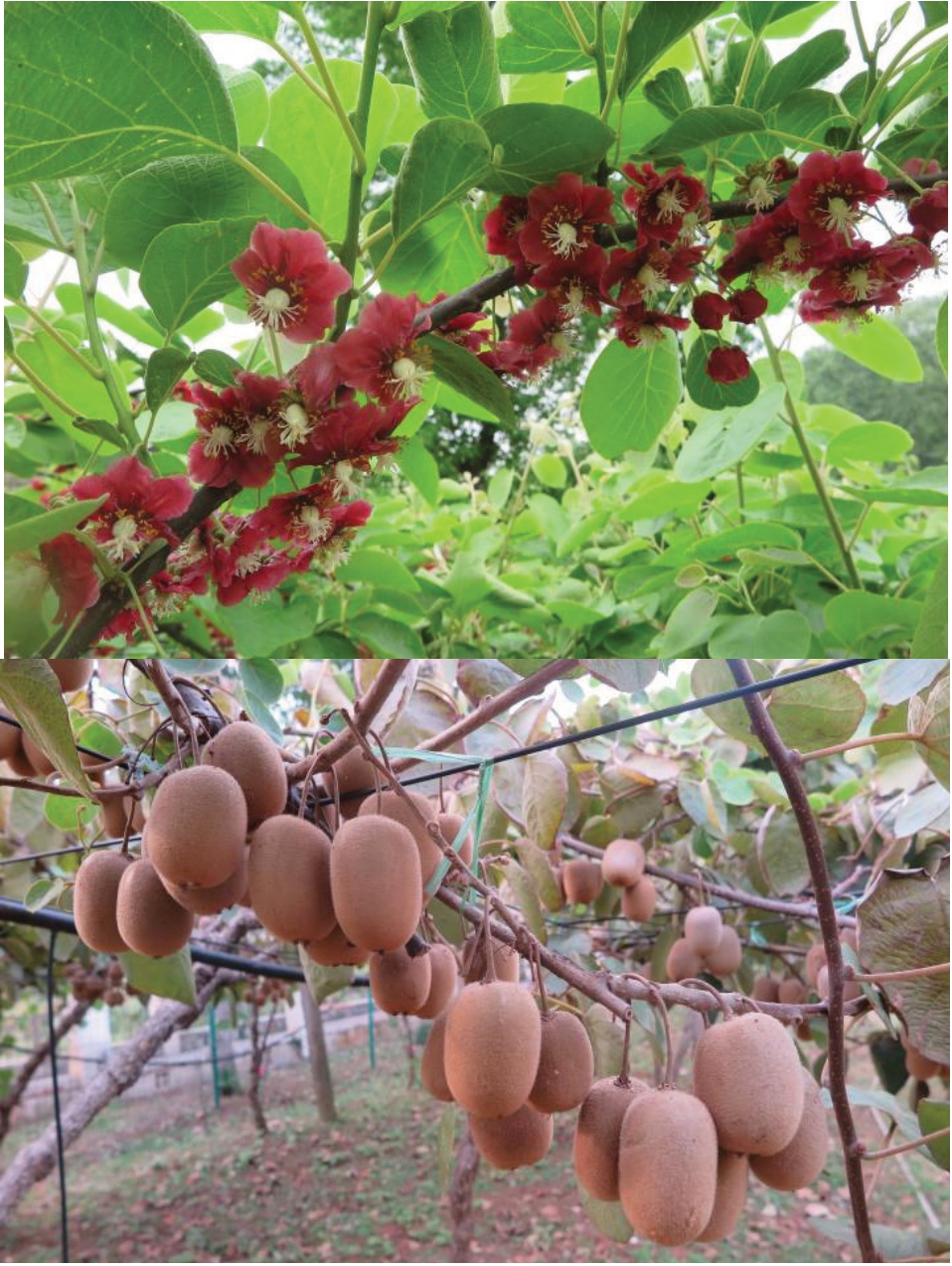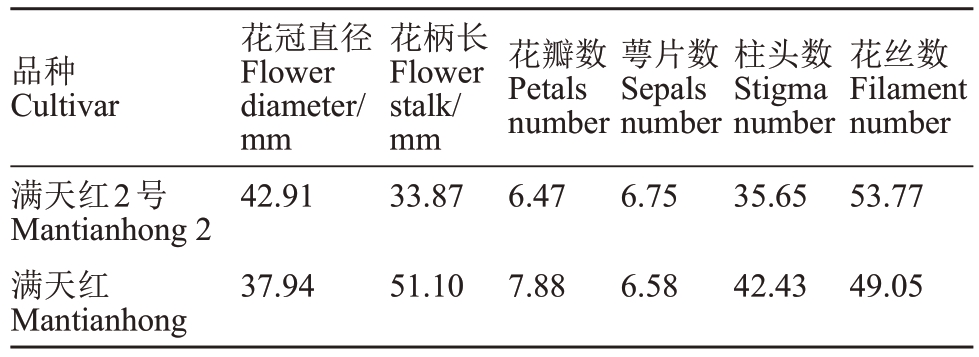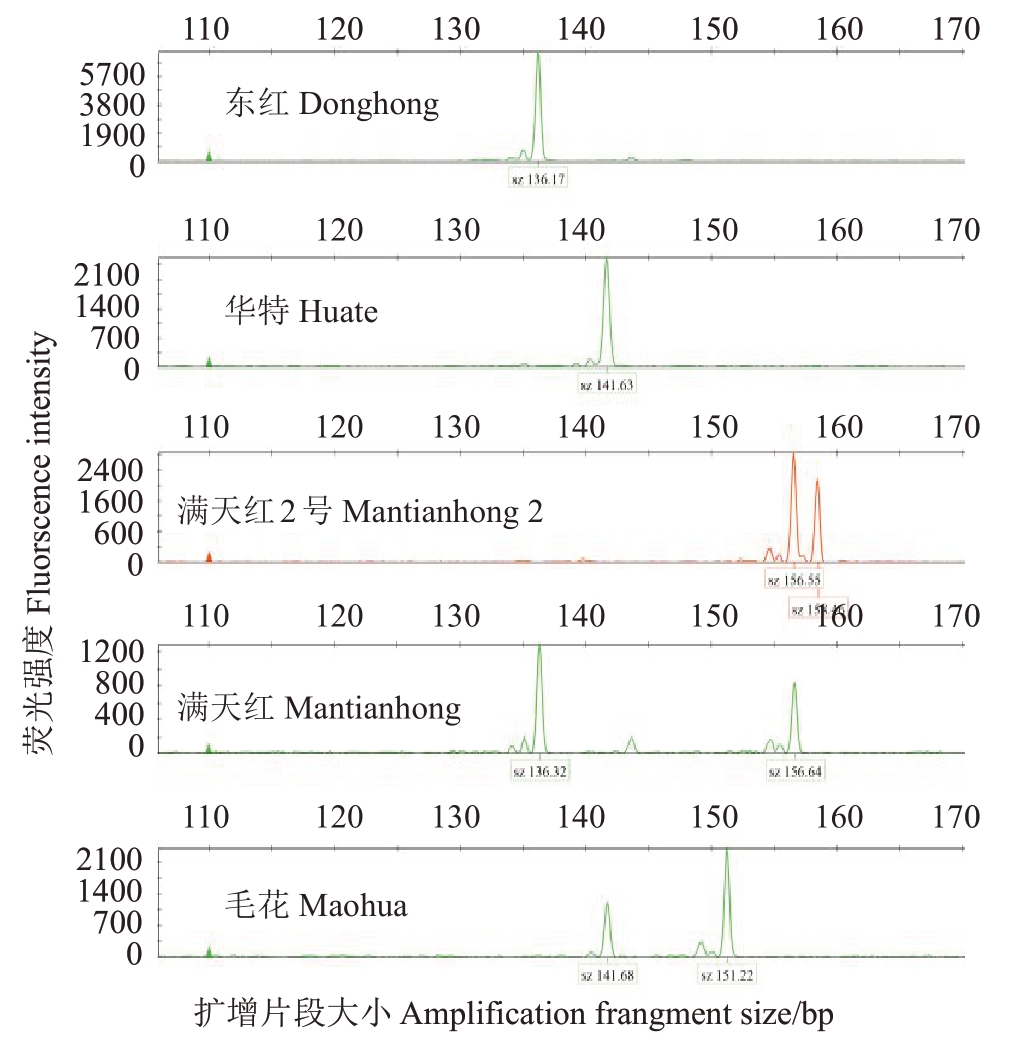选育和发展综合性状良好的早、中熟优质耐贮品种是猕猴桃持续高效生产的重要保障[1]。猕猴桃属植物的花性状具有很高的遗传多样性,不仅表现在花器官的各部分形态、颜色差异较大,开花时间、开花期长短等都存在明显变异,是选育观赏型品种的优良资源库。在猕猴桃属中,开红色或粉红色花的有网脉猕猴桃(变种,Actinidia cylindrica var.reticulata C.F.Liang)、毛花猕猴桃(A.eriantha Bentham)、粉毛猕猴桃(A.farinose C.F.Liang)、簇花猕猴桃(A.fasciculoides C.F.Liang)、条叶猕猴桃(A.fortunatii Fin.et Gagnepain)、黄毛猕猴桃(A.fulvicoma Hance)、密花猕猴桃(A.rufotricha var.glomerata C.F.Liang)、浙江猕猴桃(A.zhejiangensis C.F.Liang)等。目前,浙江园艺研究所已经通过野生资源选育了开红花的毛花猕猴桃华特[2],中国科学院武汉植物园的研究人员也通过种间杂交获得了超红[3]、江山娇[4]等开红花的观赏品种,满天红[5]可观赏与鲜食兼用。但观赏与鲜食兼用的大果型猕猴桃品种还较少,随着市场的不断需求,将可食用品种和观赏品种的特性结合起来,培育出既能观赏又能食用的猕猴桃特异新品种已成为新的育种目标之一。
1 选育过程
中国科学院武汉植物园于2009年10月,收集资源圃内开放授粉的毛花猕猴桃种子,同年12月温室播种,2000年获得杂种实生苗28株,2001年3月2日按0.5 m 株距全部定植,2004 年有8 个单株开花结果,其中5 株开白花,3 株开红花,开红花中编号为‘7-11-14’的单株由于果实偏小,2005 年1 月仅作为资源在资源圃1区嫁接保存5株,一直未关注。2010年8月,调查发现嫁接子代中编号为‘1-16-3-2’的单株果实比母株更大,花红色,花色稳定,且结果性好,果实长圆柱形,一致性好,当年9月采集果实进行品质分析,软熟后果肉黄色,可溶性固形物含量(w,后同)达16%,风味品质优。2011 年1 月取‘1-16-3-2’单株接穗高接5株,2012年开始结果,经2012—2013年连续2 a 观察,嫁接后遗传性状稳定,丰产性和果实品质与母株基本一致,在武汉地区9 月下旬成熟。2014 年12 月继续采集子代接穗在大树上高接10 株,2015 年开始结果,同时在湖北丹江口、宜昌、恩施等地种植,经过多年田间观察、DUS 测试及果实品质分析,各地综合表现均要优于选育地武汉。2020 年获得农业农村部植物新品种权(品种权号:CNA20172333.1),并命名为满天红2号(图1)。

图1 观赏与鲜食兼用猕猴桃新品种满天红2 号
Fig.1 A new edible ornamental kiwifruit cultivar Mantianhong 2
2 主要性状
2.1 植物学特征
满天红2号为二倍体品种,树势中等偏强。枝、叶、果特性偏向中华猕猴桃,而花色比毛花猕猴桃更深。1年生枝阳面颜色为褐色,皮孔短梭形,皮孔密度中等。成熟叶片形状为心脏形,正面绿色,叶片基部形状为心形,边缘有锯齿,叶柄正面花青苷显色较弱,叶柄长62.24 mm,幼叶顶端形状为渐尖,基部交叉情况为相接。花以单花为主,花柄长33.87 mm,花深红色,花冠直径平均42.91 mm,花瓣6~8 枚,萼片6.75 枚,柱头白色,分布不规则,平均35.65 枚,花丝紫红色,约53.77枚,花药黄色(表1)。
表1 满天红2 号与对照品种满天红的花性状比较
Table 1 Comparison of flower characters between Mantianhong 2 and control Mantianhong

注:表中数据为连续3 a 的平均值。下同。
Note: The data are the average values for three consecutive years.The same below.
品种Cultivar花瓣数Petals number萼片数Sepals number柱头数Stigma number花丝数Filament number满天红2号Mantianhong 2满天红Mantianhong花冠直径Flower diameter/mm 42.91花柄长Flower stalk/mm 33.87 6.47 6.75 35.65 53.77 37.94 51.10 7.88 6.58 42.43 49.05
2.2 果实经济性状
果实圆柱形,果肩方,果喙端形状平,果面密被褐色短茸毛。平均单果质量84.28 g,果柄长43.73 mm,果实纵径58.16 mm,横径45.99 mm,果形指数1.26;果肉黄色,汁多,果心较大,黄白色,椭圆形,果实采后常温下约15 d左右可食用,风味酸甜,浓郁;软熟果实可溶性固形物含量16.90%,总糖含量10.48%,可滴定酸含量1.31%,糖酸比为8,维生素C 含量101mg·100g-1,钾含量335mg·kg-1,钙含量46.5mg·kg-1。
2.3 生长结果习性
树势中等,成枝力较强。1 年生枝萌芽率平均51.36%,花枝率87.46%~99.44%,以单花结果为主。在湖北武汉、宜昌及丹江口三地开展区域试验,经品质比较,果实成熟时间基本一致,果肉颜色稳定,在宜昌地区种植平均单果质量可达96.23 g,盛果期产量可达1230 kg·666.7 m-2;丹江口地区种植果实品质较好,可溶性固形物含量为18.25%,干物质含量为20.14%(表2)。
表2 满天红2 号与对照品种在湖北区域试验结果
Table 2 Production demonstration test results of Mantianhong 2 in Hubei province

地点Test area湖北武汉Wuhan county,Hubei province湖北宜昌Yichang county,Hubei province湖北丹江口Danjiangkou county,Hubei province品种Cultivar满天红2号Mantianhong 2满天红Mantianhong满天红2号Mantianhong 2满天红Mantianhong满天红2号Mantianhong 2满天红Mantianhong成熟期Maturing date 9月下旬Late Sept.9月下旬Late Sept.9月下旬Late Sept.9月下旬Late Sept.9月下旬Late Sept.9月中旬Mid.Sept.平均单果质量Average fruit mass/g 83.56 75.33 96.23 85.39 82.68 80.65 w(可溶性固形物)Soluble solids content/%16.90 16.60 17.10 16.50 18.25 17.33 w(干物质)Dry matrer content/%18.36 17.81 18.76 17.89 20.14 18.45每666.7 m2产量Yield per 666.7 m2/kg 1050 1026 1230 1165 1100 1068
2.4 物候期
在湖北武汉地区,3月初萌芽,3月底开始现蕾,4月14日左右始花,盛花期在4月16日左右,4月22日左右谢花。果实成熟期在9 月底,果实发育期约165 d,为中熟黄肉猕猴桃品种,与近似品种满天红成熟期接近。成年树一般在12月中下旬开始落叶。
2.5 抗性和适应性
经多年多点实验表明,该品种适应性较强,耐热性比中华猕猴桃和美味猕猴桃差,特别适于冬暖夏凉区域种植。抗病性中等,如花期和幼果期遇连续阴雨,易感染果实软腐病,如遇极端低温或倒春寒逆境,易感染溃疡病。
3 分子标记鉴定
利用团队开发的SSR 标记引物,对满天红2 号在内的5个毛花或中华系列的品种进行分子鉴定分析,毛细管电泳结果表明,满天红2号在等位基因上与其他品种存在明显的差异(图2)。

图2 引物1 在5 份猕猴桃材料中的毛细管电泳检测结果
Fig.2 Capillary electrophoresis results of primer 1 in five kiwifruit materials
4 栽培技术要点
4.1 建园和定植
满天红2 号宜选择在低海拔区域,冬天最冷月平均温度在-2 ℃以内种植,极端低温不要超过-5 ℃。生产上宜采用平顶大棚架或T形棚架,采用单主干双主蔓树形培养;若作为庭院观赏,可作多种造形。定植行距4 m,株距(2.5~3.0)m,裸根苗可在落叶后定植,营养钵苗可在5月前定植即可,苗木定植后浇透水。
4.2 整形修剪
以夏季修剪为主,及时抹除位置不当的新梢,不计划作为下年结果母枝培养的枝条可在花后适当短剪,增加园区采光;冬剪修剪为辅,剪去缠绕枝、病虫枝和过密的结果母枝,留下来的枝条根据粗度回剪至相应位置,修剪完成后针对2 cm以上伤口要及时涂抹伤口保护药剂,并及时清理修剪枝条。
4.3 土肥水管理
全年施肥2~3 次,秋冬季在果实采收后及时施入冬肥,一般在11—12 月施入,每株施入成品有机肥20~30 kg,磷肥0.5 kg,或等量的腐熟农家肥;春季萌芽前每株可施入复合肥0.5 kg,谢花坐果1周后每株施入高钾复合肥0.5 kg。冬季树体休眠时可用微型旋耕机对全园进行旋耕20 cm,增加土壤通透性。夏季注意土壤湿度,及时浇水。
5 综合评价及应用前景
与满天红相比,满天红2号花色更鲜艳,果实更大,果形一致性也更好,果实成熟后风味浓郁,是一个观赏与鲜食兼用的中熟黄肉新品种。适合在城郊农业发展或庭院种植,花期可赏花,果实成熟时可采摘,也可进行温室商业栽培。
[1]雷玉山,王西锐,刘运松,张清明,贺炳荣,牛歆雨.猕猴桃中熟新品种华优的选育[J].果树学报,2007,24(6):869-870.LEI Yushan,WANG Xirui,LIU Yunsong,ZHANG Qingming,HE Bingrong,NIU Xinyu.A new mid-season kiwifruit cultivar Huayou[J].Journal of Fruit Science,2007,24(6):869-870.
[2]谢鸣,吴延军,蒋桂华,张庆朝,张慧琴,彭尚进,刘康猛.大果毛花猕猴桃新品种华特[J].园艺学报,2008,35(10):1555.XIE Ming,WU Yanjun,JIANG Guihua,ZHANG Qingchao,ZHANG Huiqing,PENG Shangjin,LIU Kangmeng.A new big fruit Actinidia eriantha Benth.Cultivar‘White’[J].Acta Horticulturae Sinica,2008,35(10):1555.
[3]王圣梅,姜正旺,钟彩虹,张忠慧,龚俊杰,黄宏文,黄仁煌.观赏猕猴桃新品种超红[J].园艺学报,2009,36(5):773.WANG Shengmei,JIANG Zhengwang,ZHONG Caihong,ZHANG Zhonghui,GONG Junjie,HUANG Hongwen,HUANG Renhuang.A new ornamental Actinidia lindely cultivar‘Chaohong’[J].Acta Horticulturae Sinica,2009,36(5):773.
[4]钟彩虹,龚俊杰,姜正旺,黄宏文,王圣梅,张忠慧,徐丽云.2个猕猴桃观赏新品种选育和生物学特性[J].中国果树,2009(3):5-7.ZHONG Caihong,GONG Junjie,JIANG Zhengwang,HUANG Hongwen,WANG Shengmei,ZHANG Zhonghui,XU Liyun.Breeding and biological characteristics of two new ornamental kiwifruit varieties[J].China Fruits,2009(3):5-7.
[5]姜正旺,钟彩虹,黄宏文,王圣梅.观赏与食用兼备的猕猴桃新品种满天红[J].中国花卉园艺,2010(18):36-37.JIANG Zhengwang,ZHONG Caihong,HUANG Hongwen,WANG Shengmei.A new edible ornamental kiwifruit cultivar‘Mantianhong’[J].Chinese Flower Horticulture,2010(18):36-37.